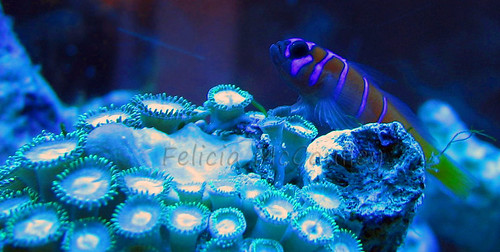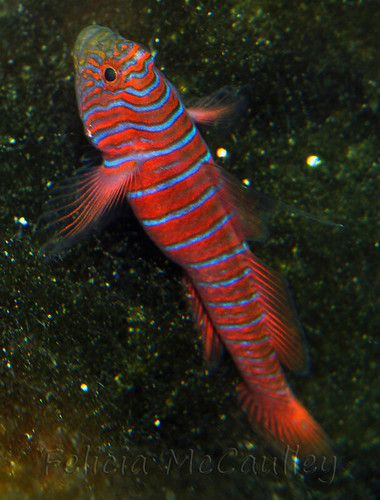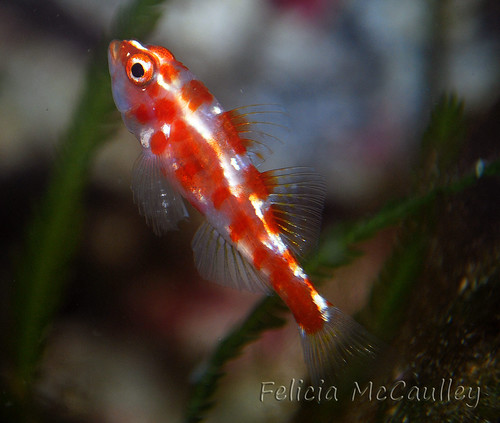
There has been a lot of focus lately on sustainable aquarium livestock harvesting and responsible aquarium keeping. The Catalina goby, Lythrypnus dalli, is notorious for being kept in inappropriate captive conditions. The picture at the left shows a captive Catalina goby perched on a sea mat "glowing" under Actinic lighting.
For years Catalina gobies were marketed as tropical fish and sold to reef aquarists. When the gobies died shortly after purchase, it was assumed that they were delicate or had short lifespans. Neither assumption is true. Catalina gobies are not tropical or sub-tropical fish. They are temperate, cold-water fish. And quite hardy, if kept in the correct environment. The maximum temperature to plan for in your home Catalina goby aquarium would be no more than 65 degrees, maintained by a chiller.
 Some retailers are beginning to notice that their customers are educating themselves about the habitats of the species they are keeping, including Catalina gobies. Some of these retailers have changed their stand on Catalina gobies and other coldwater stock, admitting that they are truly temperate. But they are still recommending the incorrect temperature range. Some retailers list the maximum temperature at 74 or 72 degrees Fahrenheit. Those are still tropical temperatures. It's a step in the right direction, but their temperature recommendation is still way too high.
Some retailers are beginning to notice that their customers are educating themselves about the habitats of the species they are keeping, including Catalina gobies. Some of these retailers have changed their stand on Catalina gobies and other coldwater stock, admitting that they are truly temperate. But they are still recommending the incorrect temperature range. Some retailers list the maximum temperature at 74 or 72 degrees Fahrenheit. Those are still tropical temperatures. It's a step in the right direction, but their temperature recommendation is still way too high.According to fishbase.org, the maximum water temperature Catalina Gobies can be found living in is 71 degrees. This is during the hottest point in summer in shallow water. Keep in mind that our reef fishes can be found in waters where the temperatures reach more than 90 degrees during the summer. For example, in the summer Brazilian Reidi and Erectus seahorses are observed in shallow waters where the temperature is above 90 degrees. Even the least responsible keepers would never attempt to keep their seahorses or reef fish at those temperatures. Our aquariums and captive reefs are very different from the wide open ocean. In captivity diseases and parasites can reproduce unchecked by inadequate dilution and overstocking (compared to the ocean). Attempting to keep any fish at the very top of its natural temperature range is going to shorten its lifespan and weaken the immune system. 71 degrees happens to be the top of a Catalina goby's temperature range.
Public aquariums have known for years that Catalina gobies must be kept at low temperatures. The Monterey Bay Aquarium houses Catalina gobies in a chilled aquarium maintained between 58 and 60 degrees. They are able to keep their Catalinas for an average of two years each and have no problems with disease. The Steinhart Aquarium in San Francisco keeps theirs at 60 degrees. Steve Weast keeps his Catalina gobies at 62 degrees or lower. He has graciously posted some fabulous photos of his Catalina gobies guarding eggs in this Reefcentral thread. The maximum temperature to plan for in your home Catalina goby aquarium would be no more than 65 degrees, maintained by a chiller.
I kept a beautiful pair of Catalina gobies in temperatures between 67 and 72 degrees for a few months. When I noticed their fast respiration and a Lymphocystis infection, I did some research then moved them to an aquarium with a temperature between 65 and 67 degrees. They recovered from the Lympho, but I was still only able to enjoy them for one year total.

There are a few more species in the Lythrypnus genus, but only two show up in the aquarium trade with any regularity. The other is the Zebra Catalina goby, Lythrypnus zebra. This species is not often collected, and the few that make it into the aquarium trade sell quickly. Not much is known about it except that its care is similar to Catalina gobies. It has a more southern range and may be able to withstand slightly warmer water temperatures. This might make it a good candidate for sub-tropical or seahorse aquariums. I've kept one in my aquarium for nearly nine months as of this post, and it is doing very well. It is eating well, as you can see from the above photo, and hasn't shown any symptoms of disease. My aquarium temperature is between 67 and 70 degrees for most of the year, but in the summer I allow it to reach 72 or 74 degrees during the hottest weeks to prevent my chiller from prematurely wearing out. I'll update this blog if anything changes.

There are tropical gobies that rival the Catalina gobies' beauty and make much better additions to a reef aquarium. Gobies from the genus Trimma and Eviota are similar in size, color, and behavior. Trimma and Eviota gobies can even be kept in small groups with less aggression than groups of Catalina gobies.
Responsibility begins with the collectors, wholesalers, and retailers, but we as hobbyists have a voice every time we purchase a specimen for our aquarium. We can educate fellow hobbyists about cold water livestock and avoid the temptation to keep them in our tropical aquariums only to enjoy them for a few months. By avoiding difficult to keep species, we can decrease demand for these animals, and fewer of them will be collected. We all play an active role in the future of the aquarium hobby.
If you are interested in Catalina goby breeding behavior, read Sex Reversal in Pairs of Lythrypnus dalli: Behavioral and Morphological Changes and Sex allocation in a simultaneous hermaphrodite, the blue-banded goby (Lythrypnus dalli): the effects of body size and behavioral gender and the consequences for reproduction.
If you are interested in setting up a coldwater reef or temperate aquarium, more information can be found on Steve Weast's website Oregonreef.com. Wetwebmedia has a very informative section on Catalina gobies here. These photos were taken in 52 degree waters near Channel Island, California.
Update: https://reefs.com/2017/03/22/coldwater-catalina-gobies/

Excellent post and beautiful fish! The key to keeping a specific fish is knowledge.
ReplyDeleteHave a great day!